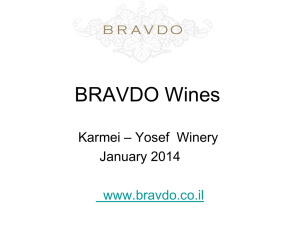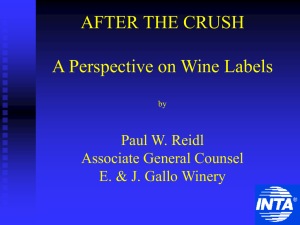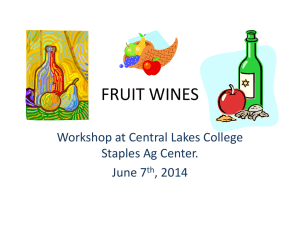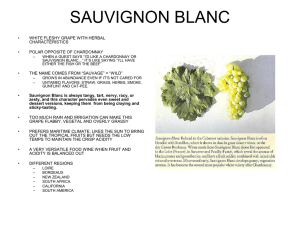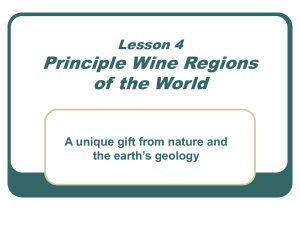Sub-regions - Treasury Wines
advertisement
WINE MAKING REGIONS INTERNATIONAL WINE REGIONS INTRODUCTION This module will introduce you to the primary wine regions around the world. WINES FROM FRANCE France is, and has long been, the most important wine producing country in the world. Many of the world’s benchmark wines and wine styles are made in France and have been produced there for centuries. Despite recent troubles of over-production, increasing competition from other countries, and ossification due to stringent wine legislation; France remains and will long remain the most important wine entity in the world. WINE REGIONS IN FRANCE: BORDEAUX Bordeaux is situated in the southwest corner of the country, the Bordeaux region is the largest, and arguably most important, wine producing region in France. The wines are predominantly red, based on blends from Cabernet-family grapes such as Cabernet Sauvignon, Merlot, Cabernet Franc, Malbec, and Petite Verdot. Wines from producers such as Chateaux Latour, Lafite-Rothschild, and Petrus are considered among the greatest red wines made anywhere. Dry and sweet white wines are also made from a blend of Semillon, Sauvignon Blanc, and Muscadelle de Bordelaise. It is important to note that the botrytis-affected sweet wines of Sauternes and Barsac are considered the among the best of their style. Beringer’s Nightingale is modeled after these wines. Wines in Bordeaux are labeled by the producer, called the Chateau. There are over 7,000 chateaux in Bordeaux, of varying sizes, making wine of various quality. WINE REGIONS IN FRANCE: BURGUNDY Burgundy is located in east-central France. Dry white and red wines are made here from the Chardonnay, Pinot Noir, and Gamay grapes. The Burgundian vineyards are a complex scheme of tiny, fragmented plots of land. The vineyards are ranked by village, premier cru and grand cru status. It’s not uncommon for a single vineyard to have multiple ownership. The finest white Burgundies (made from Chardonnay) and red Burgundies (from Pinot Noir) are among the greatest wines in the world. WINE REGIONS IN FRANCE: CHAMPAGNE The Champagne region is located in northeast France, at the far northern limits where fine wine grapes can be successfully cultivated. Historically ripening grapes consistently has long been an issue. However, it was found that the thin still wines of Champagne made from the Chardonnay, Pinot Noir, and Pinot Meunier grapes, were the perfect base to make brilliant sparkling wines. The Methode Champenoise, or Champagne method, involves a secondary fermentation that takes place in the bottle. This method is used throughout the world to make fine sparkling wines. Only sparkling wines made in the Champagne region of France can legally be called Champagne; all others are simply sparkling wine. WINE REGIONS IN FRANCE: ALSACE Alsace lies in eastern France on the Border of Germany. The region has been part of Germany several times over the last 150 years and elements of both cultures and languages have been intermixed. Alsace has a dry, warm, and sunny climate due to the Vosges Mountains, that create a rain shadow effect on the region. Most Alsace wines are dry and white, produced from grapes such as Riesling, Pinot Gris, Gewurztraminer, and Muscat. Some excellent late-harvest dessert wines are also made. WINE REGIONS IN FRANCE: THE RHONE The Rhone Valley lies in southern France and is subdivided into the Northern Rhone and the Southern Rhone. Dry white wines from Viognier and dry red wines from Syrah are made in the Northern Rhone. Dry white wines from Marssanne and Rousanne, dry rosés from Grenache blends, and dry reds from Grenache blends are made in the Southern Rhone. Look for Viogniers from Condrieu, Syrahs from Côte Rotie and Hermitage, and Grenache blends from Chateauneuf-du-Pape. WINE REGIONS IN FRANCE: LOIRE VALLEY At 625 miles, the Loire is France’s longest river. Wines from the Loire Valley offer the greatest diversity of grape varieties and wine styles from any French wine region. There are over 60 appellations, regions, in the Loire. Major grape varieties include Sauvignon Blanc, Chenin Blanc, Muscadet, Cabernet Franc, and Gamay. Look for dry white wines from Savenierres, (Chenin Blanc) dry and sweet white wines from Vouvray (Chenin Blanc), and dry white wines from Sancerre and Pouilly-Fumé (Sauvignon Blanc). Also look for dry red wines from Chinon and Bourgueil (Cabernet Franc). WINES FROM GERMANY Germany’s vineyards total less than one-tenth that of France and the country’s per-capita wine consumption is 2/3 less than Italy’s. However, Germany’s best dry and sweet Rieslings are considered to be among the world’s great wines. The far-northerly latitude has always made cultivating wine grapes a challenge. To meet that challenge, many of the vineyards are planted on steep south and southwest slopes to take advantage of summer sunlight. Grape varieties such as Riesling and Silvaner are selected because they can withstand the cold temperatures of the spring and late fall. Some outstanding Pinot Noir is also made in the warmer regions. WINES FROM GERMANY The best German wines are designated by the grape sugar content at harvest and residual sugar content at bottling. The sweetest wines, called Trockenberrenausle, are considered the best wines. There has been an important recent move to emphasize the best dry wines from the great vineyards. WINES FROM SPAIN Although Spain has over four million acres of vineyards, the country’s arid climate results in very low average yields —and wine production is only half that of France or Italy. The last 15 years have seen a dramatic revolution of technology and quality in Spanish wines. The country has great regional diversity in its wines. The most important include the dry white Albarinos of Rias Biaxas in the northwest corner, dry reds from Rioja in central Spain, sparkling Cavas made in Penedes, and the great fortified sherries of Jerez de la Frontera. WINES FROM SOUTH AFRICA The first vines in South Africa were planted near modern-day Cape Town in the mid-17th century. But it was not until the Huegenots arrived in the 1680’s that viticulture and wine-making began on a serious scale. By the mid-18th century South African wines were one of Britain’s major vinous exports. The modern South African wine industry dates only to the end of Apartheid in 1994. From that time on, the country has had access to foreign markets and a great influx of foreign capital has produced an explosion of small, boutique South African wineries. Between 1996 and 2001, a new winery opened its doors in South Africa every 17 days. WINES FROM SOUTH AFRICA Most of the wine regions in South Africa lie within 100 miles of the coast. Further inland the climate becomes far to hot to successfully cultivate wine grapes. South African wines are labeled by the grape variety, and common bottlings include Chenin Blanc, Sauvignon Blanc, and Chardonnay for whites; and Cabernet Sauvignon (and Cabernet blends), Merlot, and Shiraz (synonymous with Syrah) for reds. Chenin Blanc is the most widely planted grape. Pinotage, a cross between Pinot Noir and Cinsault, is South Africa’s original grape and wine. WINES FROM AUSTRALIA Few countries have made their mark on the wine world as dramatically in the last 20 years as Australia. Starting in the mid-1980’s, finely crafted Aussie varietal wines at low price points made their way into virtually every export market and quickly gained enormous popularity. The Australian philosophy of blending grapes and wines from different regions (the country geographically is almost as large as the U.S.) has been a large part of this success, as well as maximum use of marginal growing regions, and outstanding winemakers and the best winemaking technology. WINES FROM AUSTRALIA Australian wines are labeled by the grape variety. Common grapes are Chardonnay, Semillon, Riesling, and Sauvignon Blanc for whites; and Shiraz (the most widely planted grape), Cabernet Sauvignon, and Grenache for reds. Shiraz/Cabernet and Shiraz/Merlot blends are common and can be outstanding. Excellent late harvest dessert wines from Semillon and Muscat are also produced. South Australia is the most important wine producing state accounting for over 50% of the country’s total output. The Barossa Valley is South Australia’s most important region. Western Australia, Victoria, and New South Wales are also important wine states. WINES FROM NEW ZEALAND Although vines were first planted in New Zealand over 150 years ago, the industry did not make its mark until the last 20 years. In that time the crisp, appealing NZ Sauvignon Blancs have become one of the major benchmarks for the grape. New Zealand is divided into north and south islands with wine producing regions on both. The cool southerly climate (remember, this is the southern hemisphere) can make ripening grapes a challenge, thus site selection is critical for vineyards. Marlborough, on the south island, is considered the finest appellation. Central Otago, also on the south island, is considered the best appellation for Pinot Noir. Wines are labeled by grape variety. The most common grapes are Sauvignon Blanc, Chardonnay, and Riesling for white; and Pinot Noir, Merlot, and Syrah/Shiraz for WINES FROM ITALY Italy produces and consumes more wine than any other country — some 800 to 900 million cases a year. Italy is also the largest exporter to the U.S. (though Australia is threatening). The country has a close proximity to the ocean and over 80% of the land is mountainous or hilly. The result is a dramatic range of micro-climates. One can see the Alps in the north and North Africa in the south. Italy is the most challenging wine country in terms of scale. There are 20 major wine regions, over 900,000 registered vineyards, and over 1,000 registered grape varieties--including hundreds of indigenous varieties. Italian wines are labeled by geography, grape variety, a combination of grape and geography, and proprietary name. WINE REGIONS IN ITALY: PIEDMONT Piedmont lies in the northwest corner of Italy. The most important wines are made from the Nebbiolo grape and named after the towns of Barolo, Barbaresco and Gattinara. The wines of Barolo, Barbaresco and Gattinara tend to be made in very small quantities. These are intensely flavored, tannic wines that usually require long-term aging to soften. Other Piedmontese wines are made from the Barbera and Dolcetto grapes. The well-known sparkling wines Asti and Moscato d’Asti are made from the Muscat grape. WINE REGIONS IN ITALY: TUSCANY Tuscany, in central Italy, is perhaps the country’s greatest wine producing region. Sangiovese is the predominant grape variety and Chianti is Tuscany’s most well-known wine and appellation. Castello di Gabbiano is textbook Chianti and one of the more well-known estates. There are dozens of other wine appellations within Tuscany, with white wines made from the Vernaccia and Trebbiano grapes, and red wines made predominantly from the Sangiovese grape with Cabernet, Merlot, and Syrah also used. The estates and production of Tuscany are larger than the small producers of Piedmont. WINES FROM CHILE The bulk of Chile's vineyards are located in the Central Valley and its sub-regions (Maipo, Rapel, Curicó and Maule). The Maipo Valley is, by far, the most famous wine growing area of the Central Valley region. The Aconcagua region is to the north, which includes the important Casablanca Valley (the source of several of Chile’s finest white wines). The Southern region includes the Itata and BioBio sub regions. The most significant physical influences are the mountains and rivers. In particular, the region’s position, relative to the Andean and coastal ranges, has a significant impact upon vine growth and development. REVIEW You should now have a good introduction to: The primary international wine regions around the world OVERVIEW OF CALIFORNIA INTRODUCTION This overview of California will give you a brief introduction to the winemaking history and frequently asked questions for California in general and Napa, Sonoma and the Central Coast. MODULE OBJECTIVES In this module you will learn: • What an AVA or appellation is and the appropriate grape content in each • An overview of the geography for Napa, Sonoma and Central Coast • Answers to some of the most frequently asked questions pertaining to the wine industry in these regions CALIFORNIA WINE REGIONS DEFINED American Viticultural Areas (AVAs) An AVA is simply a Place of Origin •Defined boundaries •Historical or common name •Distinct growing conditions Place of Origin — Mandatory Grape Content US 100% State or County 75% (except California) 100% Appellation 85% Specific vineyard 95% California has 89 of the 146 U.S. AVA’s 5 California Regional AVAs 1. North Coast 4. Sierra Foothills 2. Central Coast 5. San Francisco Bay 3. South Coast CALIFORNIA FACTS 1841 California’s first winery-(in Sonoma, General VallejoLachryma Montis “Tears of the Mountain”) 1850 California statehood 1876 Beringer Vineyards established 1920–33 Prohibition – Winemaking stopped. (Beringer made wine for the churches during Prohibition) Currently over 3,700 wineries California produces more wine than all other US states combined, which is more than Australia California: 90% of US production – US is the 4th largest producer in the world Most planted varieties: Chardonnay, Cabernet Sauvignon NAPA VALLEY GEOGRAPHY Napa Valley is 30 miles (48km) long and 3–5 miles (5–7km) wide. With the Mayacamas Mountains west and the Vaca Mountains east, 14 AVAs. South: Carneros, Napa, Yountville are Cool (like Coonawarra, North Okanagon, Northern Burgundy). Commonly planted varieties include; Chardonnay, Pinot Noir, Merlot, Syrah. North: St. Helena, Howell Mtn, Spring Mtn are Warm (like Barossa Valley , Southern Rhone and Bordeaux). Commonly planted varieties include; Cabernet Sauvignon, Merlot and Sauvignon Blanc. NAPA VALLEY FACTS Wappo Indians named Napa “Land of Plenty” 1861 First winery: Charles Krug (Jacob Beringer — cellar foreman) 1876 Beringer Vineyards: Longest continuously operating winery, through prohibition and beyond 373 wineries in Napa County 38,000 vineyard planted acres (15,000 hectares) 4% of California’s wine production SONOMA GEOGRAPHY Sonoma County is 58 miles (93 KM) long and 24 miles (38 KM) wide (double Napa's size) Sonoma Mountains west and Mayacamas Mountains east Sonoma has 14 AVAs South and West are cool which includes Carneros, Sonoma Coast, Russian River, (like Burgundy and Eden Valley) North and East are warm which includes Sonoma Valley, Knights Valley, Alexander Valley, Dry Creek (like Hunter Valley, Bordeaux and Tuscany) SONOMA FACTS Sonoma: Indian for “earth village” (Jack London named it “Valley of the Moon”) 1841 Sonoma established California’s first winery (General Vallejo) 1858 Agonston Haraszthy — ”Father of California Wine” Established Buena Vista Winery (Charles Krug apprentice) 1875 Pre-Phylloxera Sonoma wines were more famous than Napa 260 wineries in Sonoma 51,000 vineyard planted acres (20,000 hectares) CENTRAL COAST: PASO ROBLES The Central Coast wine region spans from Monterey county in the north to Santa Barbara county to the south Paso Robles, in the center of the Central Coast, is situated 20 miles (12km) inland from the Pacific Ocean, (literally halfway between Los Angeles and San Francisco) Most Planted Varieties: Cabernet Sauvignon, Merlot, Zinfandel, Shiraz and Chardonnay CENTRAL COAST: SANTA BARBARA The Santa Ynez and San Rafael mountains form a unique coastal range, opening directly to the Pacific Ocean. This region is one of the coolest viticultural areas in California (like the Yarra Valley) 3 AVAs Santa Maria Valley, Santa Ynez Valley, Santa Rita Hills 100 wineries in Santa Barbara County 21,000 vineyard planted acres (8,500 hectares) REVIEW You should now have a good understanding of: • What an AVA or appellation is and the appropriate grape content in each • An overview of the geography for Napa, Sonoma and Central Coast • Answers to some of the most frequently asked questions pertaining to the wine industry in these regions OVERVIEW OF AUSTRALIA INTRODUCTION TO AUSTRALIA This overview of Australia will teach you about the Australian Geographical Indications. There is a brief summary of the most prominent wine regions of Australia and the grape varieties grown there. MODULE OBJECTIVES In this module you will learn: • How Australian wine regions are defined by the Geographical Indications and how they relate to California's AVA's. • The primary growing regions of Austalia and the grape varieties grown there. ABOUT AUSTRALIA • One of the world’s preeminent wine producing countries • An innovator in vineyard and winery management • Size: roughly the equivalent of Western Europe or the continental U.S. • Climate: Sub-Tropics, Mediterranean and Desert • Great diversity of soil types and micro-climates • Fruit-dominated wines that enjoy global popularity GEOGRAPHICAL INDICATATIONS Restructuring and redefining Australian wine appellations Originated in 1994 with European Union agreement allowing Australia access to European markets Resolving appellations vs. blending issue and the creation of the South-Eastern Australia appellation A work in progress… AUSTRALIA VERSUS USA Product of Australia: Most general designation. No vintage or variety required on label Product of Australia = USA Multi-State/South-Eastern Australia: Enormous appellation covering most producing areas South Eastern Australia = Western US State of Origin: Next most specific category Super Zone: Adelaide Zone: Barossa Valley State of Origin = California Super zone = North Coast Zone = Napa County Sub-regions: Smaller appellations within a region High Eden Sub-regions = Carneros SOUTH EASTERN AUSTRALIA Only multi-state appellation Crucial to the industry’s philosophy of blending Includes parts of Queensland, New South Wales, Victoria, Tasmania and South Australia Produces over 70% of Australia’s wine — principal wine producing companies established in Barossa, most subscribe to multiregional blending SOUTH AUSTRALIA White grapes: Riesling, Chardonnay, Semillon and Sauvignon Blanc Red grapes: Shiraz, Cabernet Sauvignon and Grenache BAROSSA VALLEY Warm dry climate requiring drip irrigation, established 1847 Low humidity, warm dry heat Perfect for ripening cycles – “physiological” Sand, loam, limestone based soils, low in nutrients and vigour Valley floor sites best for Shiraz, Cabernet and Semillon MCLAREN VALE South-East of Adelaide Maritime influenced and diurnal shift Ripe fruit with high natural acidity and good structure Known for big ‘mid-palate’ structured reds — Shiraz and Cabernet ADELAIDE HILLS The hills overlooking Adelaide Vineyards planted at up to 1500 ft Wide variety of soil types and micro-climates Together with the Yarra Valley they are two of Australia’s definitive cool climate regions Cool climate varieties – Chardonnay, Riesling, Pinot Noir COONAWARRA Area: 5x1 miles / 7x1.5 km Finest Australian Cabernet Sauvignon but also excellent Shiraz Cool climate with an abundance of underlying water (great artesian basin) Terra Rossa soils (red sandy loam over chalk) REVIEW You should now have a good understanding of: • How Australian wine regions are defined by the Geographical Indications and how they relate to the American Viticultural Areas (AVAs). • The primary growing regions of Australia and the grape varieties grown there.

